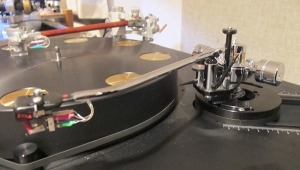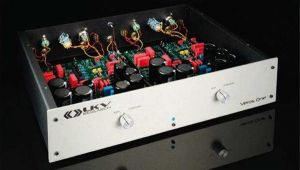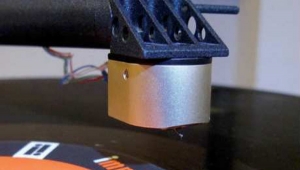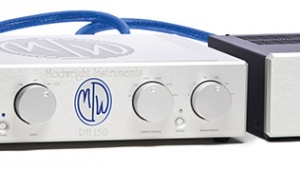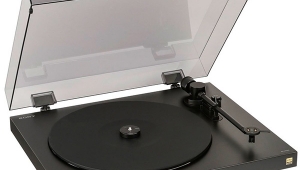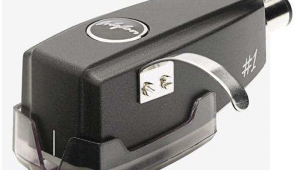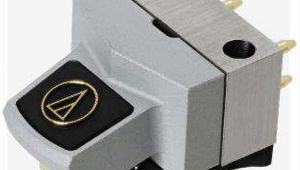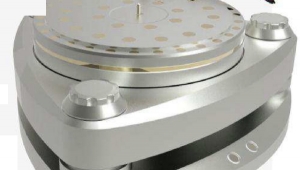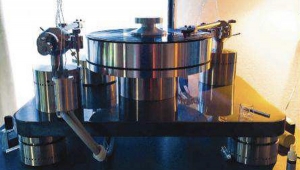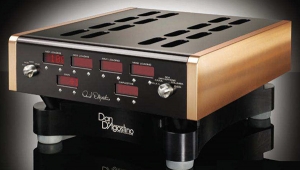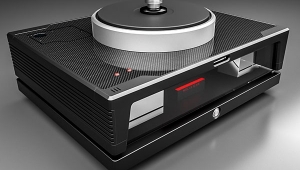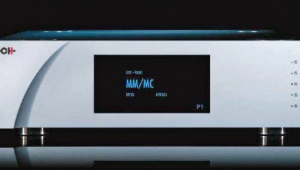| Columns Retired Columns & Blogs |
Analog Corner #249: LKV Research Veros One phono preamp, Triangle Art Apollo MC cartridge Page 2

LKV Veros One Sound: Depending on your system, you can run the Veros One all balanced, all single-ended, single-ended in and balanced out, or balanced in and single-ended out. Would balanced in and out have produced an audible difference in the level of noise? I don't know—I ran the Veros One single-ended in and out, and with the volume way up and nothing playing, it was essentially dead quiet. With music playing, backgrounds were inky-black.
One of the first records I played was the Syd Lawrence Orchestra's Big Band Spectacular!, a recent direct-to-disc recording by producer Mike Valentine, made at George Martin's AIR London Studios (2 LPs, Chasing the Dragon VALDC002). The set's second LP is of the same performance, recorded on 2" analog tape on an ATR Magnetics deck, and mixed to ½" tape on another ATR deck. This album of tunes by Glenn Miller, Benny Goodman, and Artie Shaw comes as close to being on the other side of the studio glass as I've heard from a recording in some time. Its rendering by the Veros One was as described above, though it wasn't the last word in phono preamps. When I switched back to my reference rig of Ypsilon VPS-100 phono preamp ($26,000) and MC-16L step-up transformer ($6000), instrumental attacks were more nuanced, sustain was generous and nourished, and decays lingered a bit longer—which was surprising, given the deep "blackness" of the Veros One's backgrounds.
Through the Veros One, the soundstage of Big Band Spectacular! was indeed deep, especially at the center of the stage. Images were rock solid and precise without being etched. With no tape to produce hiss, backgrounds were as "black" as I could expect or hope for, and music emerged from it in a way that was unforced and utterly natural.
Most important, in my opinion, were the instrumental timbres. In "Moonlight Serenade," the massed woodwinds and reeds had believable textures and timbres, each credibly separated within the group. The rhythm section of piano, bass, and drums was equally well reproduced, with transients cleanly delivered without sounding etched. The Veros One's reproduction of this recording was transparent, three-dimensional, and spatially stable; still, more weight can be had—for a lot more money.
I liked this sort of sound, though some might prefer more warmth and a bit of velvet. Yet when I switched to Mobile Fidelity's sonically stupendous 45rpm reissue of Santana (2 45rpm LPs, Columbia/Mobile Fidelity Sound Lab MFSL 2-45012), the tonality was completely different—a sure sign of a component's neutrality. The bottom end on this recording is thunderously deep and maybe not quite fully controlled, while the percussion in "Evil Ways" has always been somewhat less than sharply drawn, giving greater weight to textures and less to transients.
That's what I wanted to hear, and it's precisely what I heard—and this was through the Marten Coltrane 3 speakers, which are not at all forgiving: They tell you what's there. I then played the "single-step" test pressing of Santana's Abraxas that MoFi had given me at the 2016 Consumer Electronics Show (2 45rpm LPs, Columbia/Mobile Fidelity Sound Lab MFSL-2-45013). (In a single-step pressing, the stamper is pulled from the plated master, instead of being plated again and then having a "mother" pulled from it that itself is then plated to produce a final stamper.) Wow! I'd never heard "Black Magic Woman" sound like this. It got the peak meters on my darTZeel NHB-458 monoblocks up past 230W!
While this spectacular sound was more a function of the single-step pressing, the Veros One was no slouch in the dynamics department (not that the 2-SB had been either). Though its low-frequency extension was impressive, I've heard even tighter, better-controlled bass—but only with far more expensive phono preamps, such as my reference Ypsilon combo.
Summary: The LKV Research Veros One is a fine-sounding phono preamplifier that will probably lack a bit of meat on the bones for some, particularly those who prefer tubes—but, as advertised, it's ultraquiet, and sounds as designer Bill Hutchins describes in the passage quoted above. With the Veros One in my system, I was fully engaged in listening to music, instead of thinking about what I was hearing or not hearing.
But a question needs answering: Is the Veros One's sound quality, at $6500, more than twice as good as that of the 2-SB at $3000? Or even just twice as good? I can't answer that for you. I think the 2-SB is a great performer that's well worth its price or even more, and it's easy to recommend.
I'm not sure I can say the same about the Veros One without directly comparing it with the 2-SB. I know that Hutchins, who has made the comparison, thinks so, or he wouldn't have introduced the Veros One. However, he's obviously prejudiced. LKV Research offers a money-back guarantee—I'm hoping that some 2-SB owner somewhere has also bought a Veros One, compared them, and will write to tell me it's worth twice as much . . . or not! But regardless of price, the Veros One is a Class A performer.

Triangle Art Apollo low-output MC cartridge
Last year, on AnalogPlanet, I reviewed Triangle Art's Zeus phono cartridge ($3999, footnote 3). Manufactured in Japan to Triangle Art's specifications, the Zeus has a solid diamond Micro-Ridge stylus, a boron cantilever, and coils of 99.9999%-pure copper. It outputs 0.3mV, has an internal impedance of 4 ohms and a claimed 30dB of channel separation, and is designed to track at 2gm. The Zeus's motor is basically a "nude," "standard issue" design (meaning traditional magnet structure and grub-screw "stopper pipe" construction), inserted in a sturdy machined aluminum top plate. I described its design as "simplicity itself."
Two things about the Zeus impressed me. One was how well it's built: with the tonearm parallel to the record surface, the stylus rake angle (SRA) measured 91°—just one degree from the ideal (footnote 4). With the azimuth set for cantilever perpendicularity (the usual starting point), the Zeus's crosstalk measured close to the specified 30dB, with the balance between the channels very close. With a very minor tweak of azimuth, the crosstalk met the 30dB spec and the two channels were within 1dB of each other.
While I cautioned readers that I can't guarantee that the Zeus they buy will be as well built as the sample I was sent, I felt that its sound and build quality were well worth the money.
Recently, like LKV Research, Triangle Art has introduced a more expensive flagship model: the Apollo, a $7999 cartridge that is also a nude design, here set into an onyx body. The Apollo's coils, like those of the Zeus, are wound with high-purity copper wire. The pins are gold plated. The description on Triangle Art's website talks about "fine-tuning and tweaking" and about the cartridge using "some of the best parts in the world"—at least some of which, I have no doubt, were also used in the Zeus, a really fine-sounding and superbly built cartridge.
The specifications of the Apollo and Zeus are more or less identical; other than the Apollo's stone body, what accounts for the $4000 difference in price? I don't know. The specs also refer to a diamond quality that has to do with visual purity, but I'm not sure what effect that might have on the sound, if anything.
Installing the Apollo was tricky—the motor is nude, and the cartridge's stone body is not tapped and threaded. The cartridge is secured to the headshell in ways similar to Miyajima Laboratory cartridges: you insert long screws at the bottom, and secure them at the top of the headshell with nuts.
The review sample came with a tiny jewel or crystal affixed to the front of the body. I didn't remove it, so I can't say what sonic effect it does or doesn't produce.
Whether it was the onyx or something else, the sounds of the Apollo and Zeus were not at all alike. The Zeus was slightly on the rich, forgiving side, but still open and uncolored overall. The Apollo sounded sharper and faster, with tightly sprung transients throughout the audioband. It produced greater excitement than the Zeus, though I'm not sure if that was because of increases in detail, resolution, or dynamics. Still, its reproduction of the Syd Lawrence Orchestra's Big Band Spectacular! direct-to-disc record was indeed spectacular without being too hi-fi. For sure, I'd pair the Apollo with a phono preamp that's on the warm side. Going from the Apollo to Lyra's Atlas SL resulted in an increase in warmth and suppleness—if you're one of those who wonder if the Atlas SL sounds cold, there's your answer.
For $8000 or less, there's higher tech and truer resolution to be had with the likes of the Lyra Etna, the Transfiguration Orpheus, and Ortofon's A95 and Anna cartridges, among others. Triangle Art's Zeus was easy to recommend, the Apollo not so much—but for those who like their sound clean, fast, and hard (sorry), the Apollo delivers.
Footnote 3: Triangle Art, 839 S. Parkglen Place, Anaheim, CA 92808. Tel: (714) 553-6474. Web: www.triangleart.net
Footnote 4: See analogplanet.com/content/how-use-usb-digital-microscope-set-92-degree-stylus-rake-angle-sra.
- Log in or register to post comments


